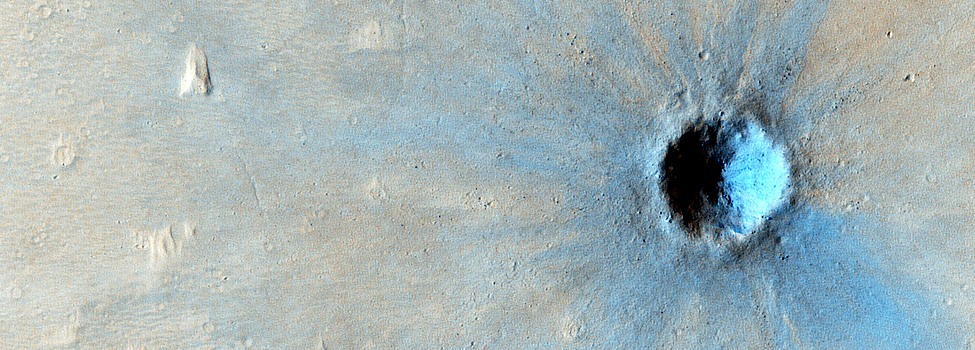Impact Processes Theme Description
Leads: Alfred McEwen, Ingrid Daubar •
Images in this theme
The high-velocity collision of interplanetary objects (mostly asteroids, also comets) with the surface of Mars creates primary
impact craters. The primary impacts may eject significant numbers of rocks at high velocity which fall back to make secondary craters.
The study of craters is important for many reasons, such as understanding cratering mechanics, attempts to estimate the ages
of terrains or processes, understanding properties of the target material
such as presence of ground ice, and understanding landscape evolution (since we have some understanding of the morphology of pristine craters).
The study of small craters (< 10 meter-diameter) can provide information about atmospheric density, and perhaps how it has varied
over time. Not all craters are of impact origin—craters can also form from volcanism or ground collapse.
Major science questions for this theme
- Can small primary craters be distinguished from secondary craters, to enable age constraints on young and/or small-area terrains?
- How much subsurface water (liquid or ice) is needed to explain ejecta flow lobes of various morphologies?
- How do terrains differ in physical properties such as density and fracturing, and how can we use craters to study this?
Relationship to other science themes
Craters form depressions which can then collect or preserve deposits such as fine layered materials, but study of those deposits
belongs in the "sedimentation and layering processes" theme. If there is evidence for past lakes or channels in or on a crater, that
belongs in the "fluvial processes" theme, and intercrater dunes would fall into "Aeolian processes." Almost any geologic process on
Mars can occur around craters, but the theme should be tied to the process of interest. The viscous relaxation of crater
topography in ice-rich ground belongs in "periglacial processes." The steep inner walls of well-preserved craters may reveal the
regional bedrock, the study of which belongs in "sedimentary and layering processes" (if exposing sedimentary rocks) or "geologic
contacts/stratigraphy" or "volcanology" (if exposing volcanic rocks) as the main themes.
Features of interest potentially visible at HiRISE scale
HiRISE can reveal the morphology and morphometry of small craters, relevant to debates about atmospheric influences and primary vs.
secondary origin, or to debates about whether a crater is in fact of impact origin. The size-frequency distribution of boulders in
impact ejecta provides information about the target material, impact mechanics, and ejecta transport mechanisms. The high-resolution
images can enable determination of whether craters are pristine or modified, and by what processes.
HiRISE images may enable identification of impact melt, important to impact energetics. We can also monitor active processes by
taking before-and-after pictures.
